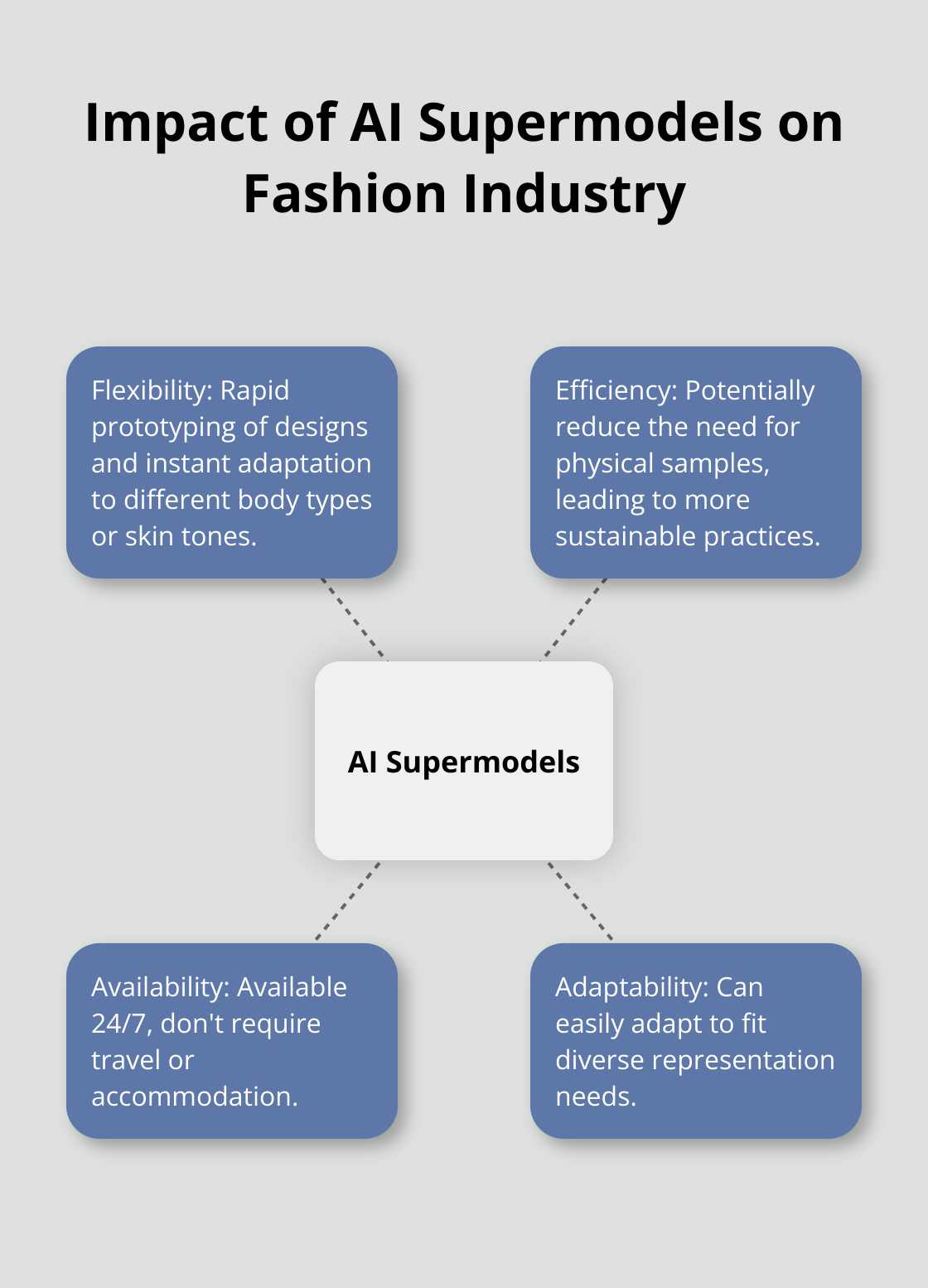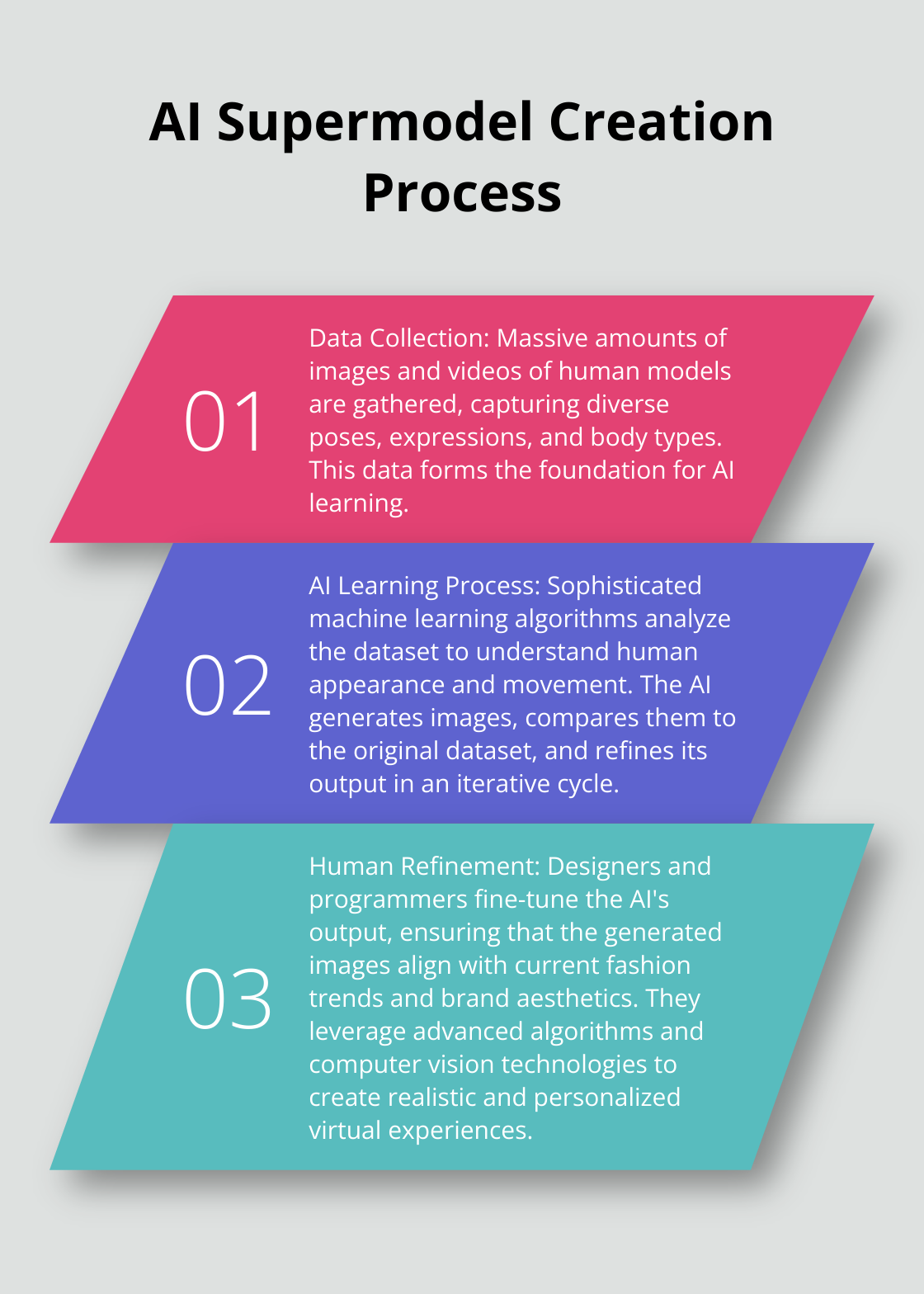At Jiu Jitsu, we’re fascinated by the intersection of technology and fashion. The rise of AI supermodels is reshaping the industry, prompting questions about who’s behind these digital creations.
Just as Gisele Bündchen’s jiu jitsu instructor shapes her physical prowess, a team of data scientists and designers mold these AI models. In this post, we’ll explore the training process, ethical considerations, and future prospects of AI supermodels.
AI Supermodels Redefine Fashion
The Digital Revolution in Modeling
In the fashion world, a new phenomenon emerges – AI supermodels. These digital creations revolutionize the industry, blending cutting-edge technology with haute couture. This trend might influence fitness and body image perceptions in unexpected ways.
Defining AI Supermodels
AI supermodels are computer-generated images or animations that mimic human models’ appearance and movements. Advanced algorithms and machine learning techniques create these digital entities, allowing them to showcase clothing and accessories with unprecedented precision and versatility.
Prominent Digital Faces
Several AI models have made significant waves in the fashion world:
- Shudu: Often cited as the world’s first digital supermodel, Shudu (created by photographer Cameron-James Wilson) has over 230,000 Instagram followers. She has collaborated with major brands like Balmain and Ellesse.
- Lil Miquela: This virtual influencer boasts over 3 million Instagram followers. She has appeared in ads for fashion companies like Chanel and Givenchy, and champions progressive causes.
Industry Impact
AI supermodels profoundly impact the fashion industry. These digital entities offer brands unparalleled flexibility, allowing for rapid prototyping of designs and instant adaptation to different body types or skin tones. This efficiency could potentially reduce the need for physical samples, leading to more sustainable practices in the fashion industry.
Moreover, AI models remain available 24/7, don’t require travel or accommodation, and can easily adapt to fit diverse representation needs. This versatility appeals particularly in our increasingly digital world, where online shopping and virtual fashion shows become the norm.

Balancing Digital and Human Elements
While AI supermodels offer numerous advantages, the irreplaceable value of human models remains crucial. Real, diverse bodies and authentic representation hold immense importance. The strength and beauty of all body types deserve celebration (as exemplified in various fitness disciplines like Jiu-Jitsu and Yoga).
As the fashion industry evolves with AI, striking a balance between technological innovation and human authenticity becomes paramount. The future of modeling likely lies in a harmonious blend of AI and human talent, each complementing the other’s strengths.
The next chapter will explore the intricate process behind training these digital supermodels, shedding light on the technology and expertise required to bring these virtual fashion icons to life.
The AI Supermodel Factory
Data: The Foundation of Digital Fashion Icons
At Souza Grappling Co., we find innovative training methods intriguing. While our focus remains on physical martial arts, the world of AI supermodels involves a different kind of training. Let’s peek behind the digital curtain and explore how these virtual fashion icons come to life.
The journey of an AI supermodel starts with massive amounts of data. Tech companies amass thousands of images and videos of human models, capturing diverse poses, expressions, and body types. This data forms the bedrock upon which AI learns to generate realistic human-like figures.
The AI Learning Process: From Data to Digital Model
Once the data collection phase ends, sophisticated machine learning algorithms take center stage. These algorithms analyze the dataset to understand the intricacies of human appearance and movement.
The learning process follows an iterative cycle. The AI generates images, compares them to the original dataset, and refines its output based on the differences. This cycle repeats thousands of times, gradually improving the AI’s ability to create lifelike digital models.

The Human Touch: Designers and Programmers Shape AI Creations
While AI does the heavy lifting, human designers and programmers play a crucial role in shaping these digital supermodels. They fine-tune the AI’s output, ensuring that the generated images align with current fashion trends and brand aesthetics.
By leveraging advanced algorithms and computer vision technologies, AI can create realistic and personalized virtual experiences for customers. This technology allows for the creation of digital models that can showcase different outfits and even mimic human-like movements for video content.
The creation of AI supermodels blends cutting-edge technology with human creativity. This fascinating process raises important questions about the ethical implications of these digital creations. In the next chapter, we’ll explore the controversies and considerations surrounding AI supermodels in the fashion industry.
The Dark Side of Digital Beauty
Diversity Dilemma
AI supermodels offer unprecedented flexibility in representing various ethnicities, body types, and age groups. However, this apparent diversity often fails to achieve true representation. Many AI models adhere to unrealistic beauty standards, perpetuating harmful stereotypes. A study by the Fashion Spot revealed that AI models were 35% less diverse than their human counterparts in 2022 fashion campaigns.
Souza Grappling Co. values authentic representation across all body types and backgrounds. The fashion industry must strive for genuine inclusivity, whether using AI or human models.
Intellectual Property Battleground
The creation of AI supermodels raises complex copyright issues. Who owns the rights to an AI model’s image? The programmers, the fashion brands, or the AI itself? These questions remain largely unanswered in current legal frameworks.
A high-profile lawsuit in 2021 between a major tech company and a fashion house highlighted this issue. The case (which centered on the unauthorized use of an AI model’s likeness) resulted in a multimillion-dollar settlement. This incident underscores the urgent need for clear guidelines and regulations in the AI modeling space.
Human Models at Risk
The increasing prevalence of AI supermodels threatens human models’ livelihoods. The International Labor Organization reports on potential occupational exposure to generative artificial intelligence (GenAI) in global employment. This shift could have far-reaching consequences for the fashion ecosystem, from agencies to photographers.
However, the human element in fashion remains irreplaceable. Human models bring authenticity and spontaneity that AI cannot replicate. The challenge lies in finding a balance that leverages AI’s efficiency while preserving the irreplaceable value of human talent.
Ethical Considerations
As AI supermodels become more prevalent, the fashion industry must address several ethical concerns:
- Transparency: Brands should disclose when they use AI models in their campaigns.
- Fair compensation: The industry must establish guidelines for compensating creators and rights holders of AI models.
- Realistic representation: AI models should reflect diverse body types and features (avoiding the perpetuation of unrealistic beauty standards).
- Job protection: The industry should implement measures to protect human models’ jobs and ensure fair competition.

The fashion world must navigate these ethical minefields carefully. The future of modeling does not lie in replacing humans with AI, but in finding innovative ways for both to coexist and complement each other’s strengths.
Final Thoughts
AI supermodels will continue to shape the fashion industry in profound ways. The technology streamlines processes, reduces costs, and offers unprecedented flexibility in design and marketing. However, the fashion world must address challenges such as diverse representation, intellectual property rights, and safeguarding human models’ livelihoods.
The future of fashion lies in collaboration between AI and human models. AI can serve as a tool to enhance human creativity, much like Gisele Bündchen’s jiu jitsu instructor helps her hone physical skills. This synergy could lead to exciting new possibilities in design, marketing, and consumer experiences.
At Souza Grappling Co., we understand the importance of balancing technology with human touch. We recognize the value of innovation in all industries while focusing on providing dynamic fitness experiences through Jiu-Jitsu, Muay Thai, and Yoga. The key is to harness new technologies in ways that enhance (rather than replace) human potential.




